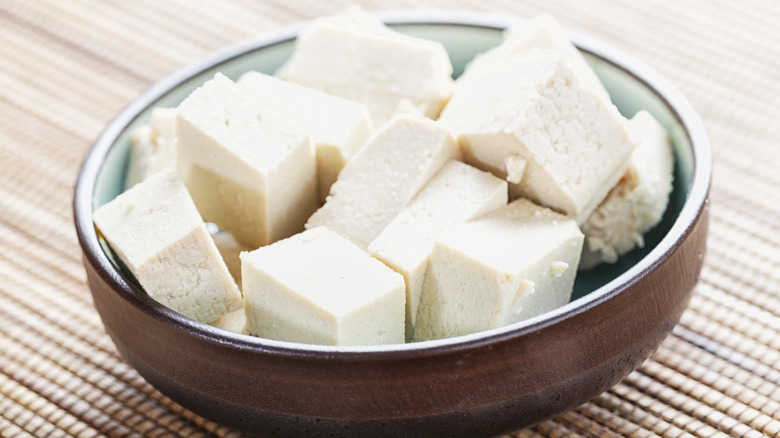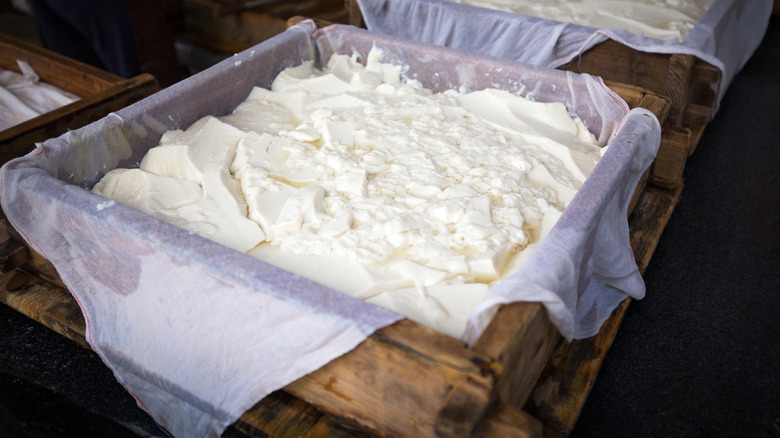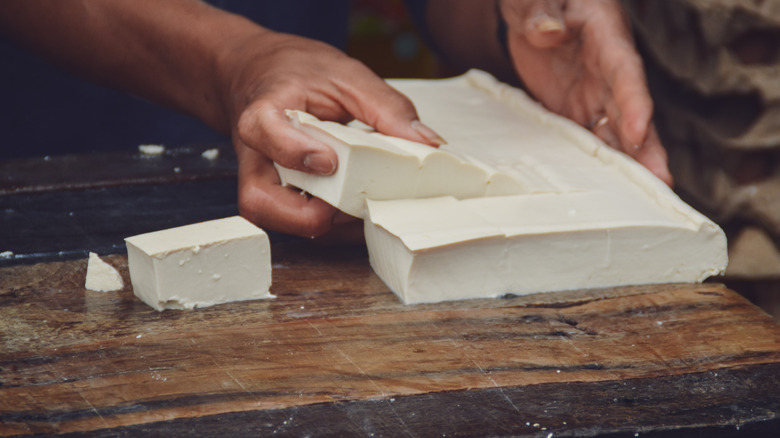What Tofu Is Really Made Of
Poor tofu. It has been made the butt of countless jokes, and mocked as a bland substitute for meat consumed by equally bland caricatures of veganism; when it is, in fact, one of the most significant and storied foodstuffs in the world. The American view of tofu is a rather limited one, with low consumption per capita and menu offerings that barely scratch the surface of the ingredient's potential. Many people don't even realize what tofu is made of.
Tofu is the Japanese term for bean curd, inspired by an ancient Chinese food called doufu. It is a byproduct of soybeans, but it isn't made from the whole bean in the way traditional soy sauce is made. Tofu is actually made from soy milk, and you can think of tofu as the soy equivalent of cheese. Just as cheese is made from coagulated animal milk, tofu is made from coagulated soy milk. Of course, the processes for making these two foods are very different.
The tofu-making process
Making tofu starts with soaking dried soybeans overnight until they absorb enough water to double in size. The beans are then mashed and boiled briefly before they are pressed to separate the soy milk from the bean pulp. This pulp is known as "okara" in Japanese, and it is a popular ingredient in its own right, used in stews, salads, and even baked goods. In industrial settings, okara can be repurposed as animal feed.
Once the soy milk has been separated, it must be solidified by curdling it, once again mirroring the cheesemaking process. Solidifying soy milk requires the addition of a coagulant — an ingredient that causes the liquid to solidify by changing its pH level. The traditional coagulant used for tofu-making is nigari, which is the liquid left over after salt has been removed from seawater.
The coagulated soy milk curds must then be pressed into their final, solid form. The longer the tofu is pressed, the dryer and firmer it becomes. Soft tofu is pressed for the shortest amount of time while extra-firm tofu gets the longest press. There is also silken tofu, which is starkly different, being uncurdled and unpressed for an extremely soft and smooth texture.
Making tofu at home
It's easier than you might think to make homemade tofu. You only need three ingredients: soybeans, water, and a coagulant. For the coagulant, you can try to find nigari, but unless you're in Japan, its commercial availability will be limited. It's easier to just use Epsom salts, or an acid like lemon juice or vinegar (bear in mind that the last two will give the tofu a slightly tangy flavor).
You might be tempted to save time by using store-bought soy milk instead of soaking the beans overnight, but be mindful of the difference between fresh soy milk and grocery store soy milk. Most commercial soy milk won't work for tofu, but if you're lucky enough to live near a producer of fresh soy milk, you could get it from them. Otherwise, just make it yourself. You can grind the beans in a food processor and strain them through a cheesecloth.
After you cook down your soy milk and add the coagulant, you'll need to press the tofu into shape. There are multiple ways to press tofu at home; but if you really get into the homemade tofu game, you could invest in a tofu press for more consistent, uniform results. Once your homemade tofu has set in the fridge, you can grill it, braise it, bake it, stir-fry it, or add it to your shrimp pad Thai.


